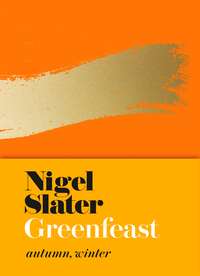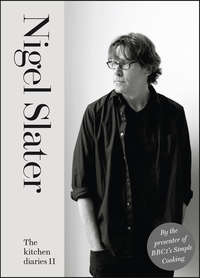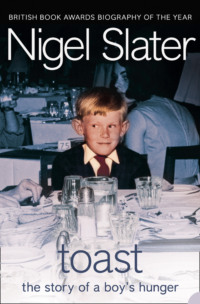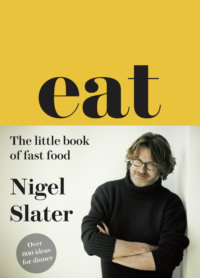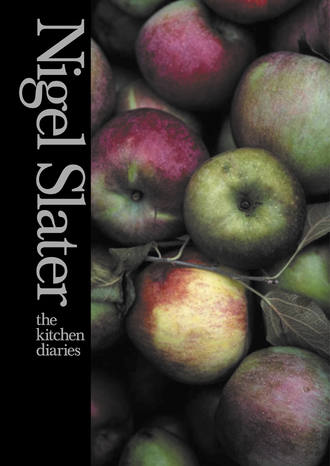
Полная версия
The Kitchen Diaries
fish supper
There is something old-fashioned about a supper of smoked haddock, something redolent of the 1950s, when women wore an apron when they cooked and would get a meal on the table at the same time each day, year in, year out. I like my smoked haddock baked with a little cream, as I do almost anything smoked, but until recently was never sure what to eat with it. Mash never seemed right, buttered toast never substantial enough, rice too reminiscent of kedgeree. It was out of curiosity that I turned to beans, pale ones from a can, their texture a pleasing contrast. Now it is one of my favourite teas, though not the prettiest.
Smoked haddock with flageolet beans and mustard
The parsley is important here and should be vivid emerald green and full of life. I see no reason why you can’t use equally mealy cannellini beans if that is what you have, though I have used butter beans before now and they were good, too. This is a mild, gently flavoured dish, consoling even, for a cold night.
smoked haddock – 400g
butter
milk – 250ml, plus a little more for later
bay leaves
flageolet beans – two 400g tins
double cream – 300ml
parsley leaves – a good fistful
grain mustard – 1 heaped tablespoon
steamed spinach, to serve
Remove the skin from the smoked haddock and place the fish in a lightly buttered baking dish. Pour over the milk, then add enough water almost to cover the fish. Tuck in a couple of bay leaves and grind over some black pepper. Bake at 200°C/Gas 6 for about fifteen to twenty minutes or until you can pull one of the large, fat flakes of flesh out with ease. Drain and discard the milk.
Rinse and re-butter the baking dish – you don’t want any bits of skin from the milk left behind. Rinse the beans in a sieve under running water, then empty them into a mixing bowl. Pour in the cream and a couple of tablespoons of milk, then chop the parsley and add it together with the mustard, a grinding of black pepper and a little salt. Go easy on the salt; smoked fish is saltier than fresh.
Spoon the beans into the dish and lay the fish on top, spooning some of the creamy beans over the top to keep it moist. Turn the oven down to 180°C/Gas 4 and bake for about forty minutes, until the cream is bubbling and the sauce has thickened around the beans. Serve with spinach.
Enough for 2
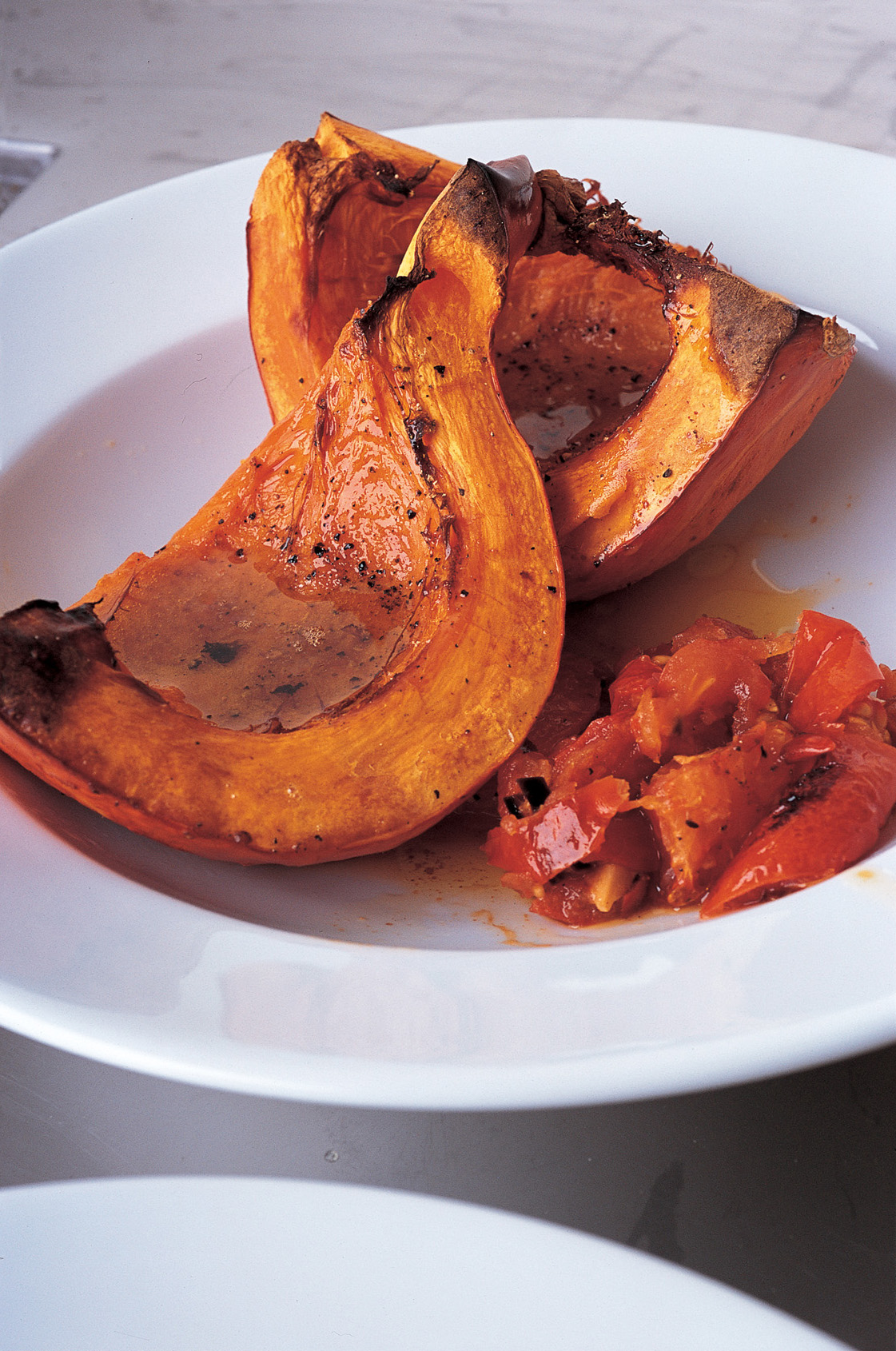
February 9
A pumpkin has been languishing in the vegetable rack for longer than I care to remember. To use it now would be more than a great satisfaction; it would be a relief.
Roast pumpkin, spicy tomato sauce
Deep red and gold, a cheering supper if ever there was one. This simple dish of roast vegetables stands or falls by the timing. I like to roast the pumpkin till it is soft but not quite collapsing, deep golden in colour, the edges slightly caramelised and sticky. Undercook it at your peril. The sauce is chunky and has a certain bitter-sweetness from the lightly blackened tomato skins. You may want to cook some brown rice to go with this, especially if you are having nothing to follow.
tomatoes – 950g
garlic – 2 cloves
chillies – 2 small hot ones
olive oil
pumpkin or squash – 1kg
Set the oven at 200°C/Gas 6. Cut the tomatoes in half and place them cut-side up on a baking sheet or in a roasting tin. Peel and finely slice the garlic, finely chop the chillies. Drizzle the tomatoes with oil, then season with salt and pepper and the garlic and chillies. Roast for forty-five to fifty minutes, till the tomatoes are soft and flecked with black.
Meanwhile, halve and peel the pumpkin. Cut into thick, melon-like slices and scoop out the seeds with a spoon. Place on a baking sheet, toss in a little olive oil and season with salt and black pepper. Roast for forty minutes, turning it over after twenty minutes or so. It is done when it is fully tender to the point of a knife and nice and sticky on the cut edges.
Roughly chop the tomatoes to give a coarse ‘sauce’. Serve alongside the roasted pumpkin, with brown rice if you wish.
Enough for 2 as a main dish
February 11
Dinner is a couple of tins of Heinz baked beans, tarted up with finely chopped chillies, several shakes of Tabasco and mushroom ketchup, and a tablespoon of black treacle. It will do.
There is no set time for eating in our house, there never has been. One day lunch will be at twelve noon, the next four in the afternoon. Supper can be as early as six and as late as midnight. Neither is our eating always leisurely. Sometimes it is just a question of getting food inside you.
Many is the time supper has been sausage sandwiches all round, either with a jar of mustard on the table, or, if I can be bothered, a pot of wasabi mayonnaise, made by beating the jade green spice-paste from its tube into some commercial mayonnaise. The sausages will be hot and sticky and the mayo shockingly spicy. The general heat is tempered by soft bread cut thick and bottles of cold beer. Other times it may be pepperoni pizzas delivered by bike or sushi or sashimi from town. Just occasionally supper will come out of a bottle.
But there are also occasions when supper is nothing at all. From a health perspective this is probably not to be recommended, but frankly that is sometimes just what I need. A lot of water will pass my lips, but no food.
For the most part, I eat one decent meal a day and then some other stuff. Under which you can file beans on toast, bacon sandwiches, fish-fingers, cheese on toast, more cheese on toast and shop-bought sushi. Sourdough bread dunked into olive oil has been dinner on more than one occasion, as have slices of rye bread with a bit of smoked salmon. Other times I just stand at the fridge eating up the remains of meals past. Cold risotto is quite nice after the initial shock, though not as much fun as cold apple pie.
But I will tell you the best trick for making your bacon sandwich, cold sausage or bit of day-old fridge-rice take on an instant appeal. Have it with a glass of wine, better still a glass of Champagne. Yes, a scavenged supper can be made to sing with pickles or fresh, rough-textured chutney, but nothing works quite as well as a glass of wine.
February 12
Another
smoked fish
supper
At the far end of the fishmonger’s slab are the smoked goods: the primrose-coloured haddock and golden mackerel; the elegantly proportioned trout, and the brick-coloured lumps of cod’s roe. There are also kippers, their skin shining silver, gold and black. Sometimes I buy one to cook for a lone supper, a slice of butter melting on its mahogany flesh. Other times, with more to feed, I make fishcakes, plump ones the size of a yo-yo.
Kipper patties, dill mayonnaise
I make these little golden fishcakes as a change from the more traditional haddock version, usually in the winter when smoky flavours seem particularly appropriate. Parsley sauce isn’t right with the kippers, so I make a dill-flavoured mayonnaise instead, or sometimes have them with nothing more than a big squeeze of lemon and a generous helping of greens.
floury potatoes – 500g
butter – a thick slice
kipper fillets – 440g
dill – a small handful, chopped
flour for dusting
shallow groundnut oil for frying
For the sauce:
chopped dill – 2 heaped tablespoons
a crushed clove of garlic
mayonnaise – 6 heaped tablespoons
Peel the potatoes, cut them into quarters, then boil them in salted water till tender. Drain the potatoes, tip them into a food mixer and beat with the butter to make a smooth but firm consistency.
Put the kipper fillets in a jug or heatproof bowl and pour a kettle of boiling water over them. Leave them for ten minutes, till they have softened, then drain and flake the flesh. I tend to leave it in short pieces the size of a postage stamp rather than finely mashed.
Fold the fish into the warm potato, together with the chopped dill and a generous seasoning of salt and black pepper. Leave the mixture to cool a little, then shape it into rough patties. I make twelve of them the size of large golf balls, then flatten them slightly. Leave them to cool and firm up.
Dust the patties lightly with flour, then fry in shallow hot oil for five minutes or so.
To make the sauce, simply mix the chopped dill with the crushed garlic and mayo.
Enough for 4
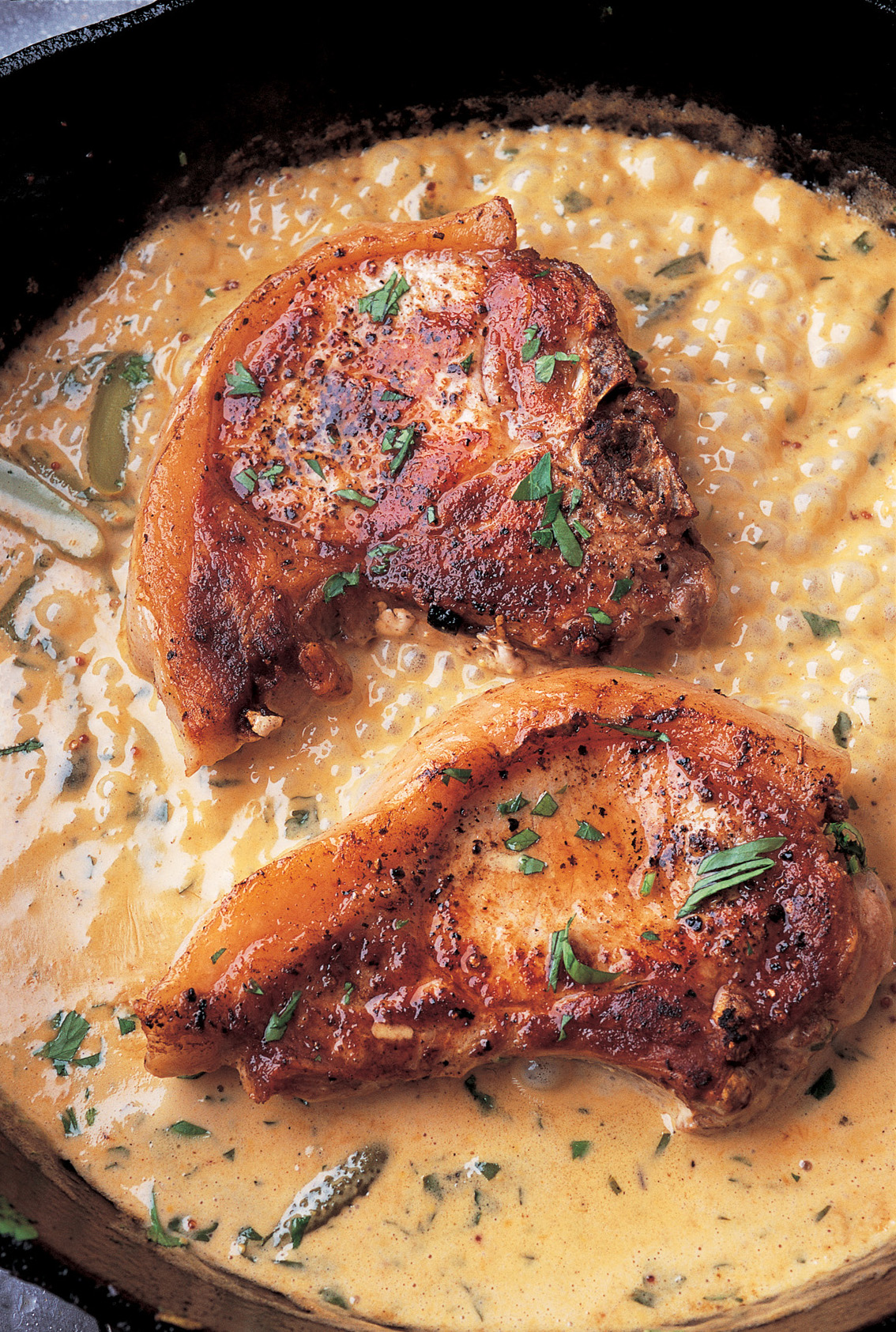
February 13
The cold and the wet have resulted in a week of ‘proper’ food; stuff to fill hollow tummies and make your ears glow with warmth. No dinky bowls of clear soup and noodles or plates of greens with shaved Parmesan and olive oil on the table this week. Rarely has our eating been so unapologetically old-fashioned. Today is no exception, and I fancy a chop, a big one with a margin of golden fat and a bone on which to gnaw. Twice this week I have used cream in the main course – a rare occurrence, but I need an iota of luxury right now to make me feel better about this endlessly grey month.
Pork chops, mustard sauce
pork spare rib or chump chops – 2 large, about 1cm thick
butter – 25g
olive oil – 1 tablespoon
garlic – 2 large unpeeled cloves, squashed flat
a glass of white wine
double or whipping cream – 150ml
grain mustard – 1½ tablespoons
smooth Dijon mustard – 1½ tablespoons
cornichons – 8, or half as many larger gherkins
Rub the chops all over with salt and pepper. Put the butter and oil in a shallow pan set over a moderate to high heat and, when they start to froth a little, add the flattened garlic and the seasoned chops. Leave to brown, then turn and brown the other side. Lower the heat and continue cooking, turning once, until the chops are no longer pink when cut into.
Lift out the chops, transfer to a warm serving dish and keep warm. Pour off most of the oil from the pan, leaving the sediment behind, then turn up the heat and pour in the wine. Let it boil for a minute or so, scraping at the sticky sediment in the pan and letting it dissolve. Pour in the cream, swirl the pan about a bit, then leave it to bubble up a little before adding the mustards and the chopped cornichons.
Taste for seasoning; you may need a little salt and possibly black pepper. The sauce should be piquant and creamy. If you want, you can finish the sauce with a few drops of liquor from the cornichon jar to sharpen it up. Pour the sauce over the chops and serve.
Enough for 2 with mashed or unbuttered new potatoes
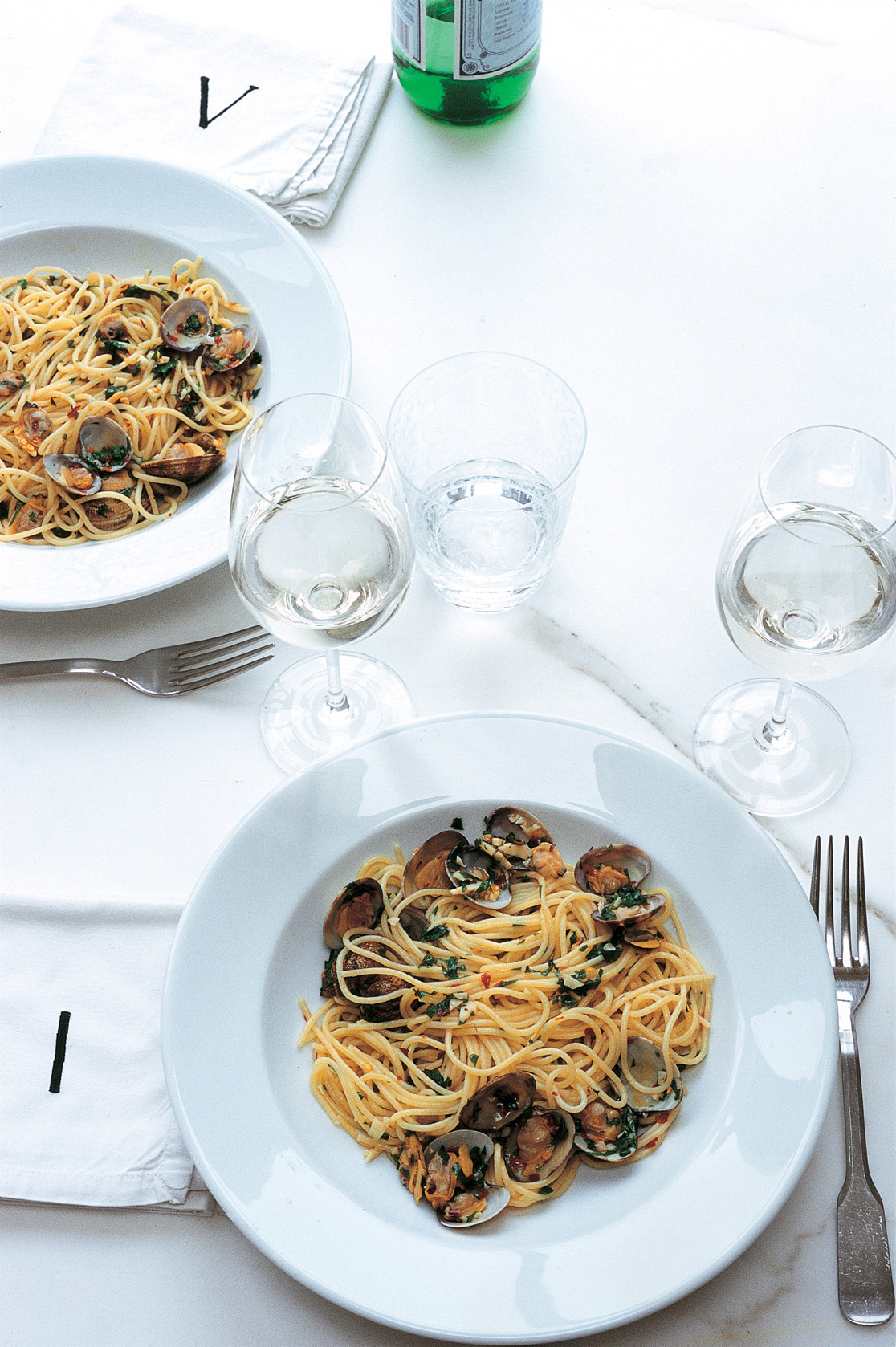
February 14
St Valentine’s
Day
I won’t eat out on Valentine’s Day, every restaurant filled with couples talking in whispers, the usual buzz and clatter reduced to a muffled sigh. Home is the place to be. More than that, there is something about cooking a special meal for someone you love that seems to mean more than simply sliding your credit card to a waiter.
I can find no reason not to go over the top on this night of the year: candles, Champagne, a chocolate pudding. St Valentine’s is rather like Christmas, in that if you ignore it you always end up regretting it, feeling mean and cynical. Yes, it is more than a bit cheesy, but I think we have to go with it.
Linguine alla vongole
small clams in their shells – 500g
a glass of white wine or vermouth
linguine or spaghettini – 300g
garlic – 2 cloves
olive oil – 3 tablespoons
crushed dried chilli – a good pinch
flat-leaf parsley – a small bunch
Scrub the clams, throwing away any that are chipped or wide open. Leave them to soak in cold water for half an hour or so. This will clear some of their inherent grit.
Put a large pan of water on to boil. Drain the clams and tip them into a medium-sized pan set over a moderate heat. Pour in the white wine or vermouth and cover them tightly with a lid. After two minutes, no longer, lift the lid and check their progress. If most of the shells are open, turn off the heat. If not, give them a minute or so longer.
Generously salt the boiling water and lower in the pasta. Lift the clams from their liquor and pick out each morsel of clam flesh. Discard the shells, but not the cooking liquor.
Peel the garlic and slice it thinly, then let it soften in a tablespoon or so of the olive oil over a low heat. It must not colour. Stir in the dried chilli, then roughly chop the parsley leaves and add them. Let them cook briefly, then strain in the cooking liquor from the clams and let it bubble down for a minute.
Test the pasta for doneness; you want it to be tender but on the tacky side. About nine minutes should do it. Drain the pasta, tip it in with the clam liquor, then stir in the shelled clam meat. Grind over a little black pepper and pour in the remaining olive oil, then toss gently and serve in warm, shallow bowls.
Enough for 2, with seconds
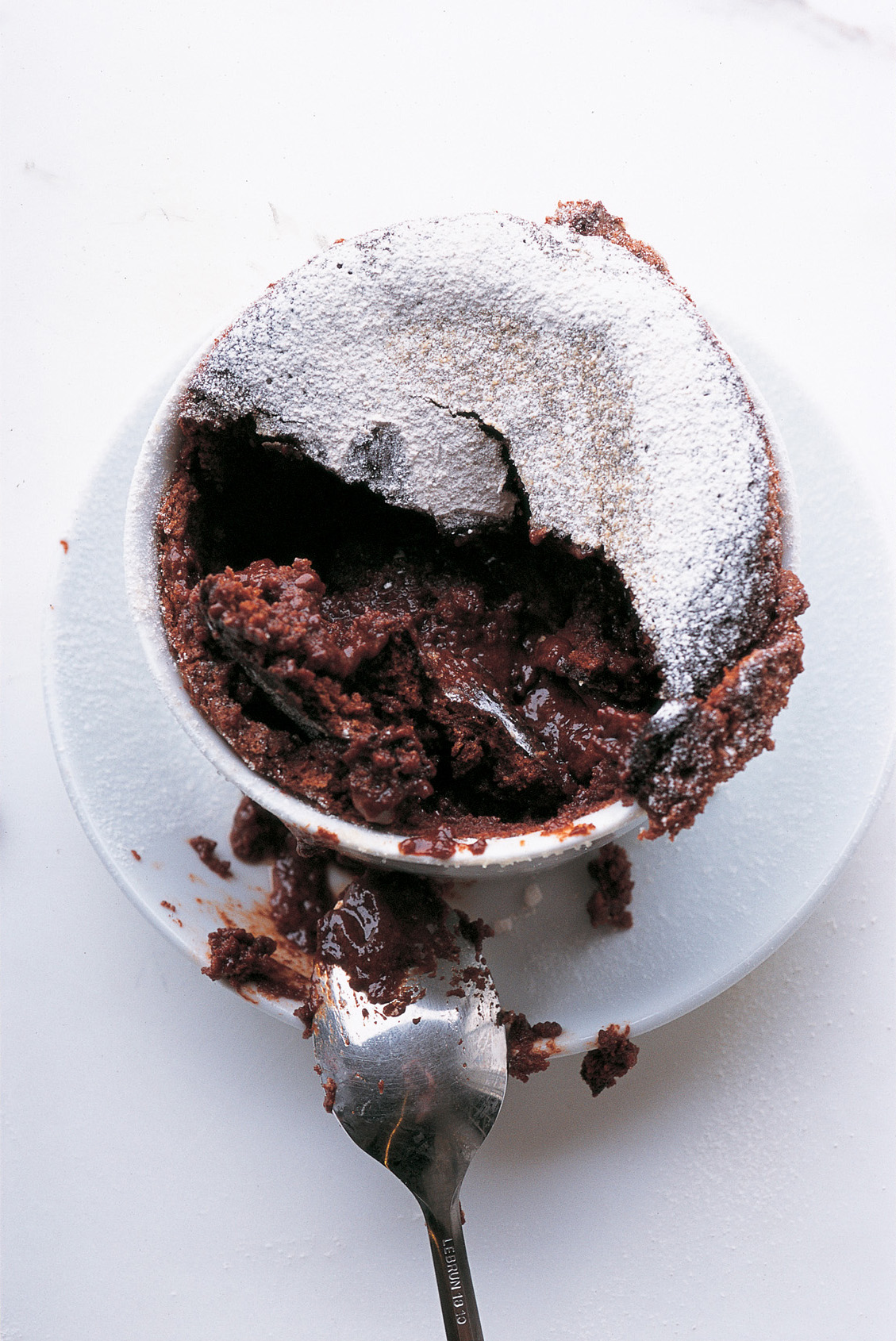
Hot chocolate puddings
It is strange that, despite having a long and passionate love affair with the stuff, I so rarely cook with chocolate. I attempt to redress the balance with these little chocolate puddings – fluffy outside and molten within, a cross between a soufflé and a sponge pudding. I make them with the best chocolate I can get my hands on. Usually Valrhona’s Manjari or something from the Chocolate Society. The hazelnut spread, such as Nutella or Green & Black’s, sounds an odd addition, an intrusion perhaps, but in fact lends a lingering, nutty depth. If you feel the need to offer cream (and well you might), make it a jug of pouring cream. This recipe is too fiddly to do for two, so I make enough for four and eat the extra two cold the next day, with a drizzle of cream.
dark, fine-quality chocolate – 200g
caster sugar – 100g
eggs – 3
butter – 60g
chocolate hazelnut spread – 2 lightly heaped tablespoons
Set the oven at 200°C/Gas 6. Lightly butter 4 small ramekins or ovenproof cups.
Break the chocolate into rough pieces and put it in a basin suspended over a pan of gently simmering water. Let it melt without stirring, occasionally poking any unmelted chocolate down into the liquid chocolate.
Put the sugar into a food mixer, separate the eggs and add the yolks to the sugar. Beat till thick and creamy. In a separate bowl, whisk the egg whites till airy and almost stiff.
Stir the butter into the chocolate and leave to melt, then gently stir in the chocolate hazelnut spread. Fold the chocolate mixture into the egg and sugar, then carefully fold in the beaten egg whites with a metal spoon. Take care not to overmix. Just firmly, calmly mix the egg white into the chocolate, making certain there are no floating drifts of egg white.
Scoop into the four buttered dishes and place on a baking sheet. Bake for twelve to fifteen minutes, till risen. The tops should be cracked and the centres still slightly wobbly. Should you open one too early, it can go back in the oven without coming to as much harm as you might think.
Enough for 4
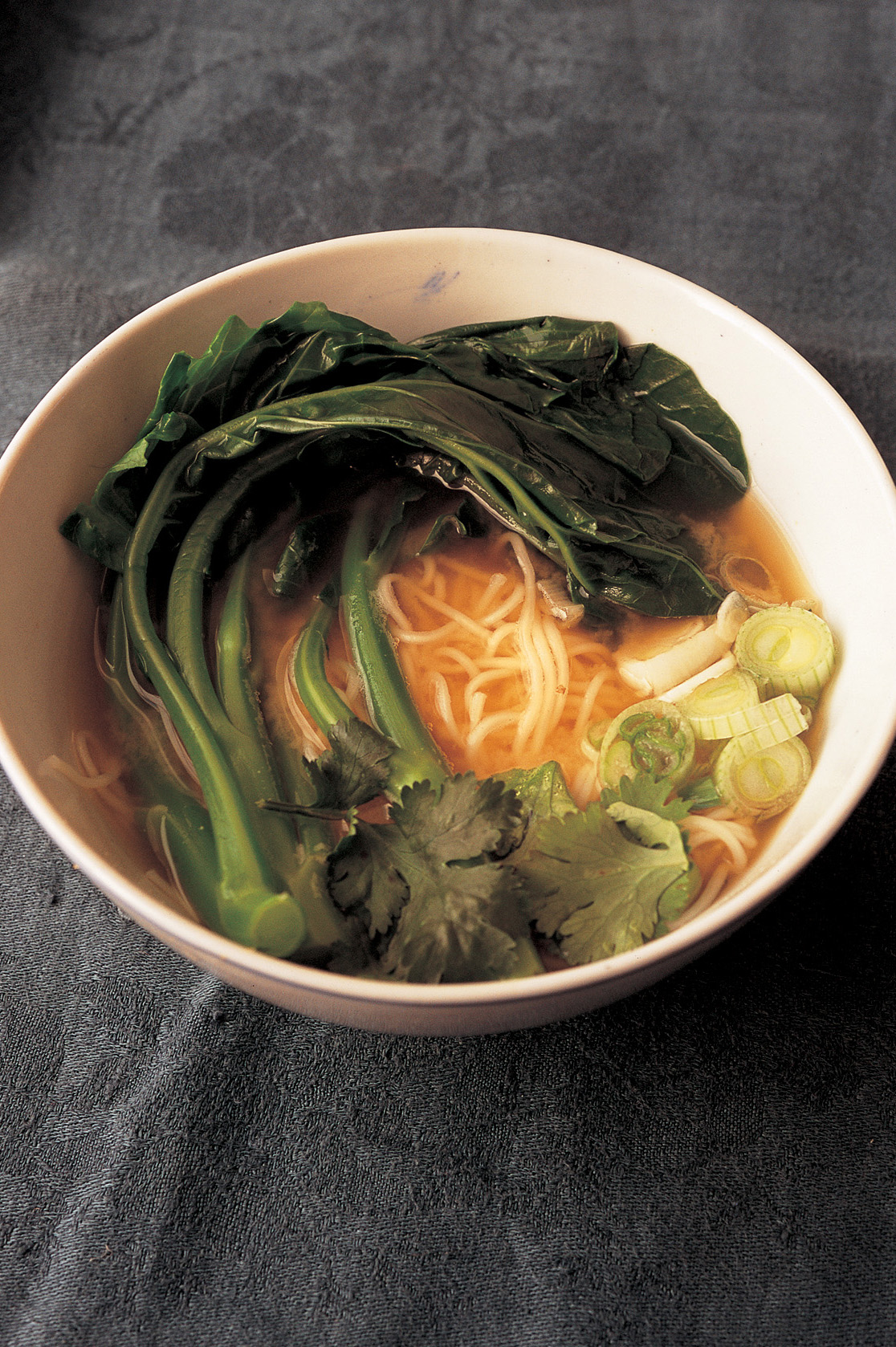
February 15
A minimal
supper
Miso soup, made with a couple of tablespoons of yellow miso paste to a litre of boiling water, is something to have on days when you really cannot be bothered to cook. It manages to be both sustaining and light at the same time, and will take anything else you care to throw at it, by which I mean mushrooms, noodles, Chinese greens or crisp French beans. Tonight I have it just as it is, a meal that stretches the notion of minimal eating to its limit. Dessert is pineapple, cold from the fridge.
February 16
I fall for some exquisitely delicate pâtisserie from a flashy new shop in Soho. Tiny pastries like jewels, and precious in the extreme. They sit awkwardly with tonight’s supper and its rough edges and big flavours. Charming though they are, the little cakes would have been much better with last night’s miso soup, proving that it is not just what you eat but how you eat it.
Sausage and black pudding with baked parsnips
onions – 2 medium
groundnut oil
medium parsnips – 4, or 2 very large
butcher’s sausages – 4
black pudding – 250g
the leaves from a few sprigs of thyme
chicken stock – 250ml
Set the oven at 190°C/Gas 5. Peel the onions and slice them in half from root to tip, then cut each half into about six or eight pieces. Soften them slowly in a tablespoon or so of oil in a flameproof baking dish or roasting tin set over a moderate heat. While they are softening, peel the parsnips and cut them into short, thick chunks. Add them to the onions and leave to colour, turning up the heat a little if needs be.
Cut each sausage into three and add to the pan. Cut the black pudding into thick slices, then cook them with everything else till they are golden on the outside. It is important that everything is a good colour before you proceed. Stir in the thyme and the chicken stock. Bring to the boil, then put in the oven for thirty to forty minutes, until the parsnips are truly tender and the stock has reduced to a syrupy glaze.
Enough for 2
February 18
A mild and
creamy
casserole
Friends and I are debating the merits of bland food, dishes such as marrow in white sauce, cauliflower cheese, porridge and, of course, risotto. My position is that there are times when you want something spicy, bright and hot, and others when you want something less taxing on the taste-buds. Occasionally the mouth and body need calming rather than stimulating. With this in mind, I make a beige casserole of tender lamb and soft leeks. There could be no better example.
Braised lamb with leeks and haricot beans
dried haricot beans – 200g
olive oil – 3 tablespoons
lamb neck fillet – 500g, trimmed and cut into 5cm cubes
large leeks – 4, trimmed, halved lengthways and rinsed
garlic – 2 cloves, finely chopped
chopped thyme leaves – 1 tablespoon
bay leaves – 2
plain flour – 1 tablespoon
double cream – 150ml
a handful of parsley, chopped
a handful of mint leaves
Soak the beans overnight in cold water. I use mineral water for this. The next day, drain them, put them into a deep saucepan and cover with fresh water. Bring to the boil, skim off the froth and simmer for about forty minutes, or until tender. Turn off the heat and leave them in the cooking water.
Warm the oil in a flameproof casserole and add the meat. It should sizzle when it hits the oil. Let the meat brown slightly all over. You may have to do this in two batches, depending on the size of your casserole. Remove the meat from the casserole and set aside.
Set the oven at 150°C/Gas 2. Cut the leeks into 5cm pieces, then put them in the casserole, with a little more oil if need be. Leave them to cook till soft and silky. You will have to give them an occasional stir to ensure they do not colour. Stir in the garlic, thyme and bay leaves. Sprinkle the flour over the top and continue cooking for three or four minutes, stirring occasionally.
Pour in 570ml water and return the meat and any juices to the pan. Drain the beans and add them too. Then bring everything to the boil. As soon as the liquid boils, cover the casserole with a lid and put it in the oven for an hour, until the lamb is completely tender. Remove from the oven, stir in the cream, parsley and mint and warm through gently on the hob before serving.
Enough for 4
February 19
A bento
box dinner
Tonight it’s bento boxes all round from a Japanese place in town – crystal noodles with coriander, red chilli and sesame seeds with tubs of crisp green edamame. I love these bright green beans and cannot stop popping them out of their pods straight into my mouth. There are crab rolls too with dipping sauce and crunchy matchsticks of cucumber.
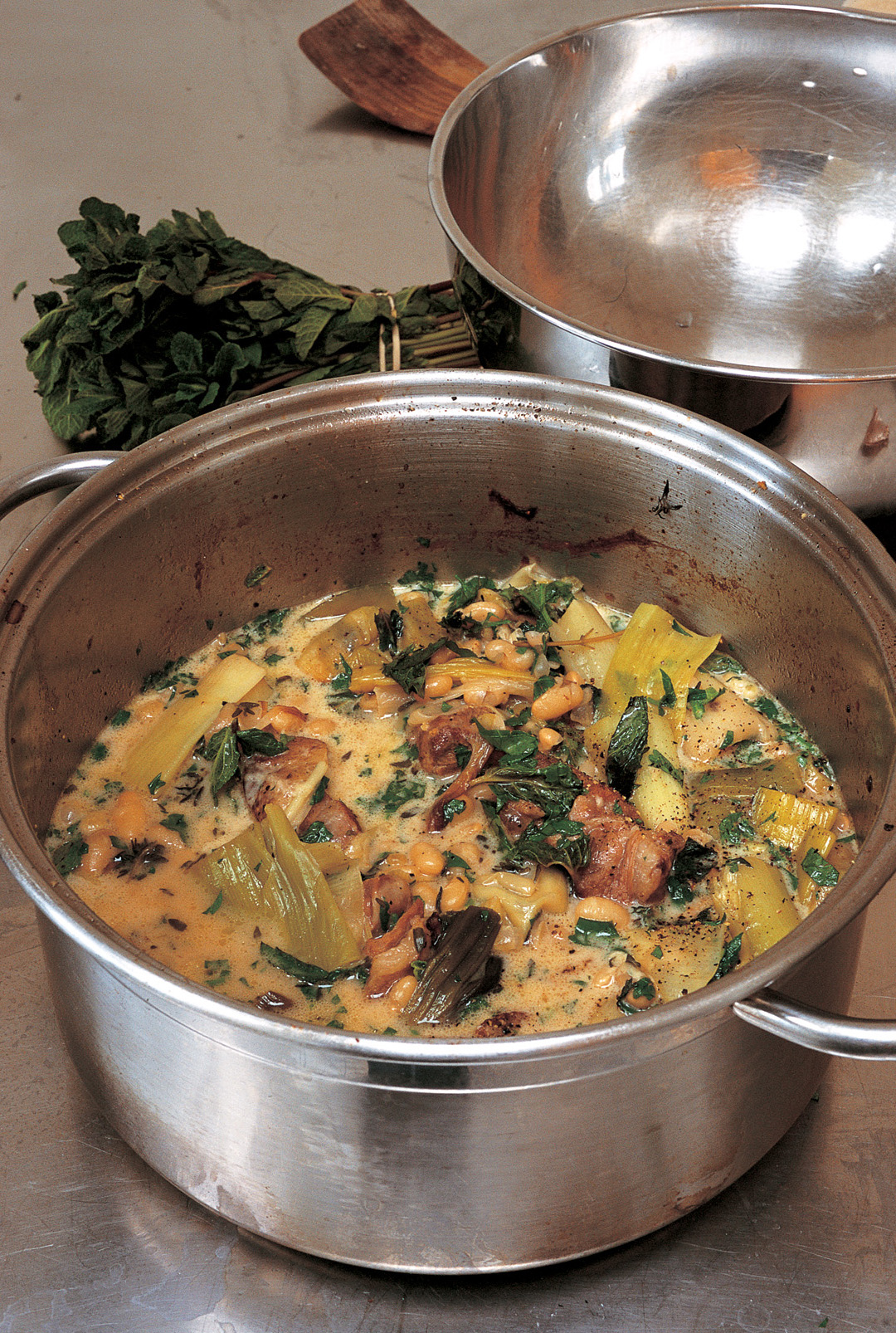
February 20
Red soup
and a
crunchy
salad
It has taken me years to figure out that when it rains I invariably make (or think about making) soup. I never noticed this till I started to write everything down.
Spiced pumpkin soup with bacon
a medium onion
garlic – 2 plump cloves
butter – 50g
pumpkin – 900g
coriander seeds – 1 tablespoon
cumin seeds – 2 teaspoons
small dried chillies – 2
chicken or vegetable stock – 1 litre
smoked bacon – 4 rashers
single cream – 100ml
Peel and roughly chop the onion. Peel and slice the garlic. Melt the butter in a large, heavy-based saucepan and cook the onion and garlic until soft and translucent. Meanwhile, peel the pumpkin, remove the stringy bits and seeds and discard them with the peel. You will probably have about 650g of orangey-yellow flesh. Chop into rough cubes and add to the onion. Cook until the pumpkin is golden brown at the edges.
Toast the coriander and cumin seeds in a small pan over a low heat for about two minutes, until they start to smell warm and nutty. Keep the pan to one side for later. Grind the roasted spices in a coffee mill or with a pestle and mortar. Add them and the crumbled chillies to the onion and pumpkin. Cook for a minute or so, then add the stock. Leave to simmer for twenty minutes or until the pumpkin is tender.
Fry the bacon in the pan in which you toasted the spices. It should be crisp. Cool a little, then cut up into small pieces with scissors. Whiz the soup in a blender or food processor till smooth. Pour in the cream and taste for seasoning, adding salt and pepper as necessary. Return to the pan, bring almost to the boil and then serve, piping hot, with the bacon bits scattered on top.
Enough to serve 4 generously
I also make a salad dressing tonight with 4 tablespoons of sake, 100g miso paste, 2 tablespoons of groundnut oil and a couple of teaspoons of sugar. I use it to dress a salad made from the following raw crunchy things: a couple of big handfuls of bean shoots, a handful of mint leaves and another of coriander, half a cucumber and a couple of carrots, shredded into matchsticks, four shredded spring onions and three red chillies, seeded and chopped. I toast 150g peanuts till they smell warm and nutty, chop them roughly, then toss the nuts, salad and miso dressing together. It makes a great, scrunchy, nutty, knubbly salad for two of us.



